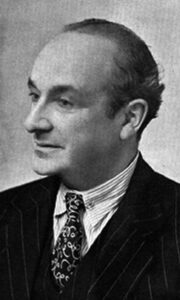Patrick A.S. Hadley
 Patrick Sheldon Hadley was born on 5 March 1899 in Cambridge. His father, William Sheldon Hadley, was at that time a fellow of Pembroke College. His mother, Edith Jane, was the daughter of the Rev. Robert Foster, chaplain to the Royal Hibernian Military School in Dublin.
Patrick Sheldon Hadley was born on 5 March 1899 in Cambridge. His father, William Sheldon Hadley, was at that time a fellow of Pembroke College. His mother, Edith Jane, was the daughter of the Rev. Robert Foster, chaplain to the Royal Hibernian Military School in Dublin.
Patrick attended St Ronan’s Preparatory School at Worthing, Sussex and Winchester College in Hampshire. However the First World War interrupted his education. He enlisted in the army and was commissioned as a second lieutenant in the Royal Field Artillery. He managed to survive unscathed until the last weeks of the war, when he received an injury necessitating the below-knee amputation of his right leg. This profoundly damaged his confidence and also caused him to perhaps drink more than was wise; he was in constant pain, for which alcohol provided some relief.
Patrick’s elder brother Peyton Sheldon Hadley, a former pupil of Charterhouse School, who served in the infantry, was also wounded in the closing months of the War. He was invalided home to convalesce, but died of pneumonia that October. A memorial to Peyton is found in the Charterhouse School Chapel.
After the war Patrick went up to Pembroke College, Cambridge, where by now his father was Master. He was fortunate to study with both Charles Wood and the English composer Cyril Rootham. Hadley was awarded B.Mus. in 1922, and an MA in 1925. He then went to the Royal College of Music in London. Here he came under the influence of Ralph Vaughan Williams for composition and Adrian Boult and Malcolm Sargent for conducting. Eric Weatherell notes that Hadley’s contemporaries at the RCM included Constant Lambert and Gordon Jacob. He won the Sullivan prize for composition: at that time the sum of 5 shillings.
He became a member of the RCM staff in 1925 and taught composition. He became acquainted with Frederick Delius (Eric Fenby describes the role played by Hadley in recovering the long-lost score of Delius’s early opera Koanga), Ernest John Moeran, Sir Arnold Bax, William Walton, Alan Rawsthorne, and Herbert Howells.
During 1937–38 Hadley assisted his friend and former teacher Cyril Rootham (by then terminally ill) in completing his Second Symphony. Acting as amanuensis, Hadley and others took dictation and transcribed the entire sketch for the symphony and the orchestration of the first two movements. At Rootham’s request, Hadley also completed the orchestration of the final movement after the composer’s death in March 1938.
In 1938 Hadley was elected to a Fellowship at Gonville and Caius College in Cambridge and appointed as a lecturer in the music faculty. Much of his time was spent in mundane administrative activities, but there was still time available for composition. Some of his greatest works were written during and after the war.
During the Second World War he deputised for Boris Ord as conductor and musical director of the Cambridge University Music Society. There he introduced a number of important works, including Delius’ Appalachia and A Song of the High Hills. He was keen to promote a wide range of music, including the formation of a Gilbert and Sullivan Society. Much of his time was spent in making arrangements for the use of the males in the choir. Sadly, few of these have survived. We know them only from programme notes and hearsay. In 1946 he was elected to the Chair of Music at Cambridge University. He retained this post until his retirement in 1962. Some of the students taught by Hadley included Raymond Leppard, Sir David Lumsden, Patrick Gowers, Sir Philip Ledger and Peter le Huray.
In 1962 Hadley retired to Heacham in Norfolk. He wished to pursue his interest in folk song collection. However, he latterly struggled with throat cancer and this caused many of his activities to be suspended. Patrick Hadley died on 17 December 1973 at King’s Lynn. He was 74 years old.
